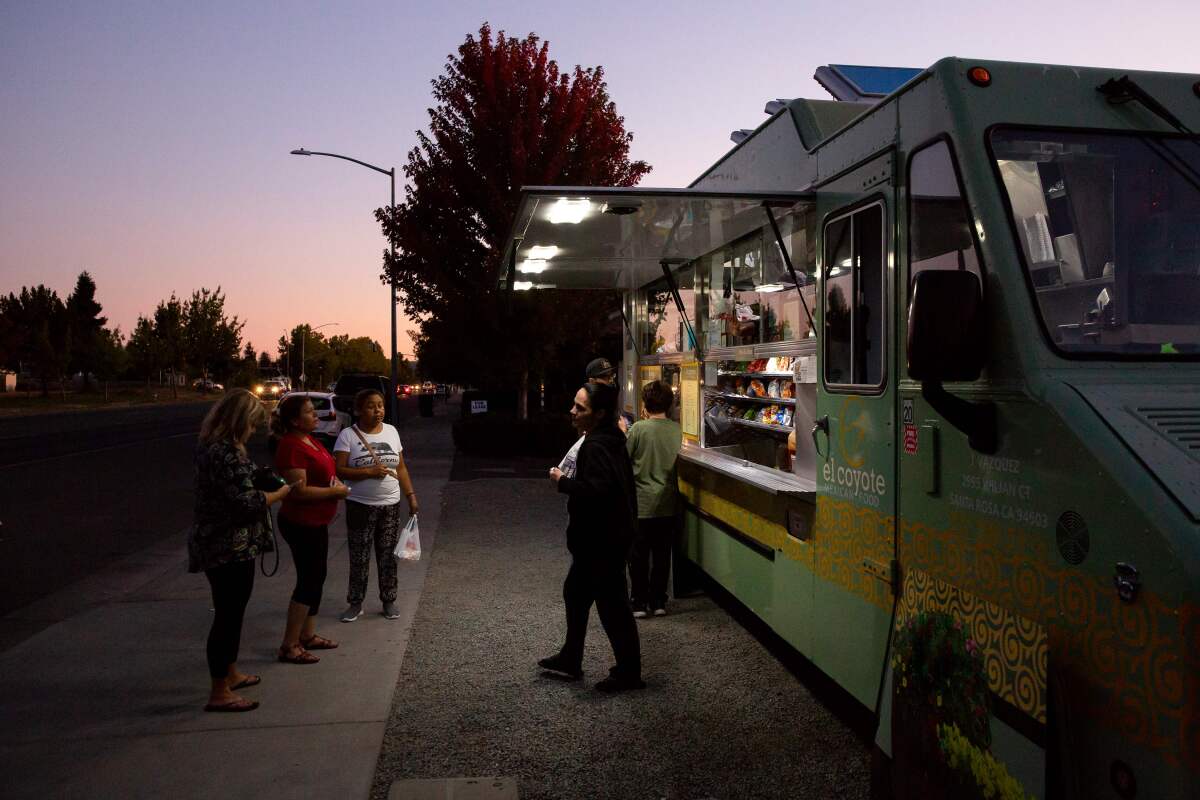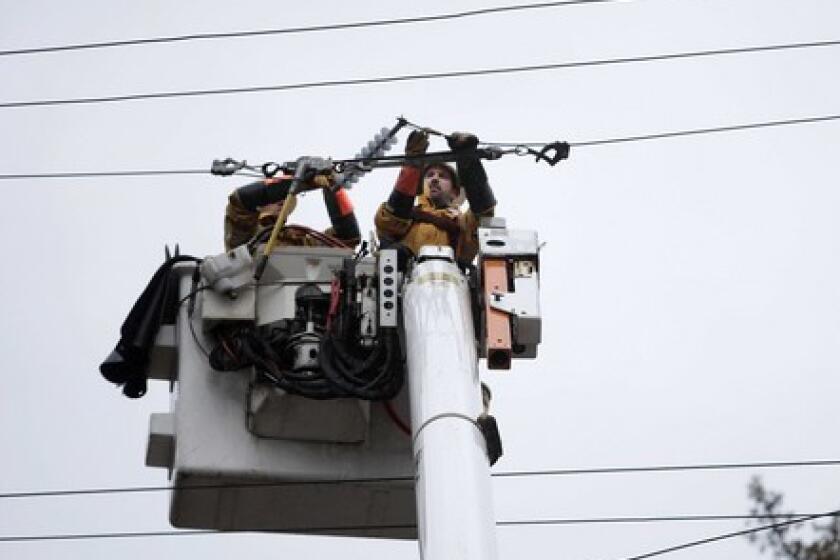Gov. Newsom slams PG&E over ‘unacceptable’ power outages and failure to fix systems

- Share via
Gov. Gavin Newsom tore into Pacific Gas & Electric Co. on Thursday, calling the mass power outages “unacceptable” and the result of the bankrupt utility’s own long legacy of mistakes.
“What’s happened is unacceptable. And it’s happened because of neglect. It’s happened because of decisions that were deferred, delayed or not made by the largest investor-owned utility in the state of California and one of the largest in the nation,” he said at a news conference. “This current operation is unacceptable. The current conditions and circumstances are unacceptable.”
For parts of Thursday, more than 1 million Californians remained without power after the state’s largest utility shut off electricity in an attempt to prevent windblown power lines from sparking devastating wildfires. PG&E said late Thursday that 738,000 customers remained without power and that it was restoring service in many areas.
Newsom said PG&E’s failure to maintain its system created the need for the outages.
“It’s decisions that were not made that have led to this moment in PG&E’s history and the state of California as it relates to our major investor-owned utility,” Newsom said. “This is not, from my perspective, a climate change story as much as a story about greed and mismanagement over the course of decades. Neglect. A desire to advance not public safety but profits.”
Responding to widespread criticism over the blackouts, the utility’s chief executive, Bill Johnson, said he was focused on PG&E’s future, not it’s past. He joined the company in April.
“I didn’t come here to deal with the past. I came here to help improve the future,” he said. “I haven’t delved into all those matters.”
He added: “There are many things we need to do better than we did this time. Communicate better, with as much notice as possible, as much clarity as frequently as possible. We did not deliver on that commitment at this time. Our website crashed. Maps were inconsistent or incorrect.”
Residents had already rushed to empty store shelves looking for batteries and water and had lined up for gas to prepare for the looming outage. They did laundry, ran dishwashers and vacuumed, fearful they would not have power for several days. Some stuffed refrigerators and freezers with ice so they would stay colder longer. Others emptied food into coolers.
But their lights stayed on, while their frustrations mounted.
The steady alerts that power would be shut off at specific times — only to have it remain on — proved more unnerving than the actual loss of electricity for some.
Mary Carey, a lawyer who lives in a wooded East Bay community, compared the situation to knowing a “meteorite is on the way, but it won’t hit for 12 hours.”
Kevin Marker, 66, a retired businessman, had another take: “I think PG&E is just getting back at people.”
By Thursday morning, the utility had turned off power to customers in Alameda, Alpine, Contra Costa, Mariposa, San Joaquin, San Mateo, Santa Clara, Santa Cruz, Stanislaus and Tuolumne counties.
It also had restored power to about 125,000 customers across the state, including 74,000 in Humboldt County. Still, officials warned, more areas could see blackouts, depending on weather conditions. The utility is still considering cutting off about 4,000 customers in the southern portion of its coverage area in Kern County.
Fierce winds blew through several counties in Northern California on Thursday, the kind of gusts that bend treetops and cause cars to swerve.
In response, the National Weather Service issued a red-flag warning for much of the region, cautioning residents to expect northerly winds between 15 and 30 mph, with gusts up to 50 mph, and very low daytime humidity. The warning is in effect through Friday.
The high winds and dry weather create ideal fire conditions, authorities warn, with the potential to transform a spark into a raging inferno. PG&E fears windblown electrical lines could spark fires if power is not cut.
About two hours northwest of Sacramento in Clearlake, residents entered their second full day without power. At the local Safeway, which had a generator to provide electricity, customers searched for ice and charcoal hoping to save or cook the groceries in their refrigerators.
At a nearby senior center, PG&E set up a charging station in a back room for cellphones and medical equipment. At least 150 people had visited Wednesday, said representative Conrad Asper. By lunchtime Thursday, there had been more than 250.
Paul Spillane, 79, expressed what was a common sentiment at the center: frustration with PG&E.
“I think it’s an outrage,“ he said of the blackouts. “I say it’s the three most miserable days I’ve had since I’ve been up here. I haven’t been eating properly or anything.“
Amee Peterson, 66, said she feels so dirty from a lack of hot showers that she’s considering boiling water on the barbecue to wash her hair. On Wednesday night, she ate cake for dinner because she couldn’t cook. Peterson, who has post-traumatic stress disorder, fibromialgia and other conditions, said she received automated calls warning her of the blackout, but they were not specific. When the power cut out at 1 a.m. while she was reading a book, she was surprised. Even more frustrating, she said, has been the lack of clarity on when power might return.
“There is no idea when it’s coming back on,“ she said.
The utility has warned that some customers may be in the dark for up to five days, even after the winds subside, as crews check equipment and repair fallen lines before restoring electricity.
Millions of Californians could spend days without power as the state’s largest utility continues shutting off electricity in a desperate attempt to avoid wildfires sparked by windblown power lines.
The PG&E blackout marks the largest power shut-off to date as California utilities attempt to reduce the risk of wildfires that have charred thousands of acres, caused billions of dollars in damage and spurred cries for widespread change in how electricity is delivered over the state’s aging grid.
Equipment malfunctions have been tied to some of the state’s most destructive and deadliest fires, including the 2017 wine country blazes and last year’s Camp fire, which devastated the town of Paradise and killed 85 people.
In January, PG&E filed for Chapter 11 bankruptcy protection, anticipating multibillion-dollar legal claims stemming from the Camp fire, which also destroyed nearly 14,000 homes. A month later, officials at the utility acknowledged that its equipment probably sparked that blaze.
At a news conference Wednesday evening, PG&E officials signaled that these types of massive shut-offs during fire season might be the new normal.
Sumeet Singh, vice president of PG&E’s community wildfire safety program, said customers should anticipate similar shutdowns in the future until the utility has finished its wildfire safety plan, “unless the weather changes significantly and the vegetation condition and the fuel-loading condition, and land and the forest management, changes significantly within the state.”
“We understand that this power shut-off is difficult for our customers and communities. Please check on your neighbors, friends and family and know that we will work safely, and quickly as possible, to restore power across the region,” Singh said.
The power shut-offs have prompted backlash, with some residents saying they create a whole new set of dangers as they try to keep up with news about fires. Critics worry that communications and evacuations will be hampered when the power is out, especially if traffic signals don’t work and cellphone service is affected.
There also was concern about how those with health issues who rely on electrically powered medical equipment to stay alive would cope without power.
State Sen. Jerry Hill (D-San Mateo) said Thursday that he sent a letter to the California Public Utilities Commission asking the panel to conduct a review of how PG&E decided which areas should lose power and how the blackouts were rolled out.
“Many questions remain unanswered as the state reels from the consequences of this decision by PG&E, chief among them why is PG&E alone in making this decision?” Hill wrote to the commission.
The outage prompted UC Berkeley to cancel classes for a second consecutive day. University officials say some buildings are running on generator power for “life safety, animal care and support of critical research infrastructure.” However, the generators cannot power the entire campus.
The Oakland Zoo also remained closed after the region lost power overnight. The zoo had closed ahead of the planned blackout, and staff rushed out to purchase additional generators to power exhibits for animal safety. The gas they have will power the generators for about four days, Darren Minier, assistant director of animal care, told the San Francisco Chronicle.
In Southern California, residents have anxiously watched how the power shutdowns have affected other parts of the state, wondering if it was a glimpse of what was to come for them.
Southern California Edison on Thursday began preventive power outages across its service area. Given the strong Santa Ana winds forecast for the area, the utility said, power could be cut off to more than 173,000 customers in parts of nine counties in Southern and Central California: Los Angeles, San Bernardino, Riverside, Orange, Ventura, Kern, Tulare, Inyo and Mono.
Times staff writers Jaclyn Cosgrove, Anita Chabria and Patrick McGreevy contributed to this report.
More to Read
Sign up for Essential California
The most important California stories and recommendations in your inbox every morning.
You may occasionally receive promotional content from the Los Angeles Times.
















